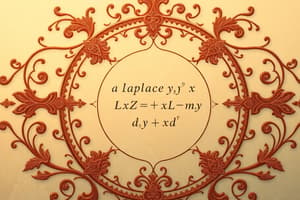Podcast
Questions and Answers
What is the solution to an equation?
What is the solution to an equation?
- Any variable value which makes the equation true (correct)
- A constant value
- The equation itself
- A variable value that makes the equation false
What are infinite solutions in linear equations?
What are infinite solutions in linear equations?
- Created by equating two equivalent expressions (correct)
- Created by unequal expressions
- Have only one solution
- Created by linear equations with different slopes
What does it mean when a linear equation has no solution?
What does it mean when a linear equation has no solution?
- The equation can be solved normally
- The expressions are of the form ax + b with identical a and different b (correct)
- The equation is an identity
- The equations have the same slope
What is the general form of a linear equation?
What is the general form of a linear equation?
What is the factored form of a linear equation?
What is the factored form of a linear equation?
What is the standard form of a linear equation?
What is the standard form of a linear equation?
What are literal equations?
What are literal equations?
To solve an inequality, one must write a function to represent the problem solution and write the function as an ______ based on the independent quantity.
To solve an inequality, one must write a function to represent the problem solution and write the function as an ______ based on the independent quantity.
What is a compound inequality?
What is a compound inequality?
What does a conjunction represent in inequalities?
What does a conjunction represent in inequalities?
What does a disjunction represent in inequalities?
What does a disjunction represent in inequalities?
Flashcards are hidden until you start studying
Study Notes
Solutions and Equations
- A solution to an equation is any variable value that makes the equation true.
Types of Solutions
- Infinite solutions occur when linear equations are created by equating two equivalent expressions.
- No solution arises in linear equations of the form ax + b, where both expressions have the same coefficient for x (a) but different constant terms (b).
Forms of Linear Equations
- The general form of a linear equation is expressed as y = ax + b, where 'a' represents the slope and 'b' indicates the y-intercept.
- The factored form is written as y = a(x - c), where 'a' is the slope and 'c' is the x-intercept.
- Standard form is represented as Ax + By = C, with A, B, and C as real numbers, and A and B not both equal to zero.
Special Types of Equations
- Literal equations are formulas or equations where variables represent specific measures.
Solving Inequalities
- Solving an inequality involves several steps: representing the problem as a function, writing it as an inequality, isolating the variable to find the solution, and interpreting the outcome.
Compound Inequalities
- A compound inequality combines two inequalities using "and" or "or."
- Conjunction refers to joint inequalities taking the form a < x < b, representing solutions that satisfy both conditions.
- Disjunction refers to inequalities structured as x < a or x > b, allowing for solutions that satisfy either inequality.
Studying That Suits You
Use AI to generate personalized quizzes and flashcards to suit your learning preferences.




